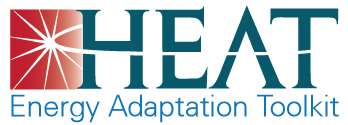-
Climate risk screening of the energy sector to identify and prioritize hazards, current vulnerabilities, and risks from projected climate changes out to the year 2050.
-
Identification of adaptation options to reduce overall vulnerability.
-
A high-level cost benefit analysis of key physical adaptation options.

-
A greater awareness and deeper understanding among stakeholders,
-
High-level (semi-quantitative) assessments of key risks and adaptation options for the energy sector,
-
Clarity on where subsequent more in-depth analyses should be focused.
-
A first workshop and series of meetings on ‘Climate risks & vulnerabilities’,
-
A second workshop and meetings on ‘Climate risk management and cost-benefit analysis’.
-
Who’s involved in undertaking the stage,
-
Timing for when to do each stage and the time required to undertake each stage,
-
Key questions that should be answered at each stage,
-
Tools to help,
-
Guidance describing what should be done at each stage,
-
Outputs of each stage,
-
Examples of how the process was undertaken in Albania (2009) and Uzbekistan (2010).
|
Stage |
Stage Description |
Timing |
Time Required |
|---|---|---|---|
|
1.1 |
|
Before ‘Climate risks and vulnerabilities’ workshop
|
5–10 days
|
|
1.2 |
Identify and mobilize stakeholders
|
Before ‘Climate risks and vulnerabilities’ workshop
|
Approx. 10 days
|
|
1.3 |
Undertake preparatory work on the risks and vulnerabilities of energy sector
|
Before ‘Climate risks and vulnerabilities’ workshop
|
10-15 days
|
|
2.1 |
Prepare risks and vulnerabilities evaluation framework for energy sector
|
Before ‘Climate risks and vulnerabilities’ workshop
|
2 days
|
|
3.1 |
Run plenary workshop session to set the scene for the workshop and engage stakeholders
|
During ‘Climate risks and vulnerabilities’ workshop
|
2 hours
|
|
3.2 |
Undertake participatory vulnerability assessment and identify risks
|
During ‘Climate risks and vulnerabilities’ workshop
|
6 hours
|
|
3.3 |
Gain views of key vulnerabilities & risks
|
During meetings after the ‘Climate risks and vulnerabilities’ workshop
|
2-3 days
|
|
3.4 |
Analyze & evaluate priority risks
|
Between ‘Climate risks & vulnerabilities’ workshop and ‘Climate risk management and cost-benefit analysis’ workshop
|
2-4 weeks
|
|
4.1 |
Undertake preparatory work on adaptation options
|
Between ‘Climate risks & vulnerabilities’ workshop and ‘Climate risk management and cost-benefit analysis’ workshop
|
1-2 days
|
|
4.2 |
Validate risk register with stakeholders
|
At start of ‘Climate risk management and cost-benefit analysis’ workshop
|
1 hour
|
|
4.3 |
Introduce CBA & agree CBA objectives & boundaries
|
During ‘Climate risk management and cost-benefit analysis’ workshop
|
3.5 hours
|
|
4.4 |
Discuss & confirm adaptation options & parameters for CBA
|
During ‘Climate risk management and cost-benefit analysis’ workshop
|
3.5 hours
|
|
4.5 |
|
During and immediately following the ‘Climate risk management and cost-benefit analysis’ workshop
|
0.5 days
|
|
5.1 |
|
During meetings after the ‘Climate risk management and cost-benefit analysis’ workshop
|
1 day
|
|
5.2 |
Discuss climate change risks associated with adaptation options
|
During meetings after the ‘Climate risk management and cost-benefit analysis’ workshop
|
1 day
|
|
5.3 |
|
Following ‘Climate risk management and cost-benefit analysis’ workshop and collection of data
|
Over a period of about 6 weeks
|
|
5.4 |
Discuss & confirm CBA with stakeholders
|
Six to eight weeks after ‘Climate risk management and cost-benefit analysis’ workshop
|
4 hours
|
|
6.1 |
Is there enough information to design and implement adaptation measures?
|
About eight weeks after ‘Climate risk management and cost-benefit analysis’ workshop
|
1 day
|
|
7.1 |
Undertake adaptation measures as per timetable
|
Work can commence once adaptation measures have been confirmed
|
Time required will vary depending on the adaptation measures
|
|
8.1 |
Monitor climate impacts on the energy sector
|
On an ongoing basis
|
As part of routine operations
|
|
8.2 |
Monitor the performance of the adaptation measures
|
On an ongoing basis
|
As part of routine operations
|
|
8.3 |
Monitor new scientific information on climate change & its impacts on the energy sector
|
Following publication of major new international and national reports on climate change and its impacts
|
Typically 1-2 days per major report
|